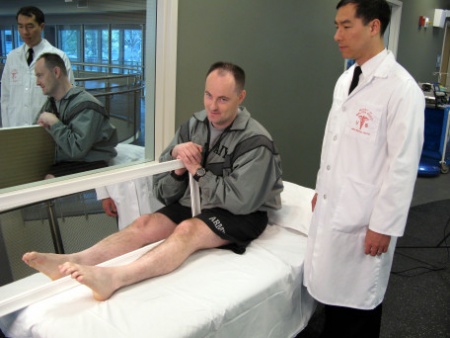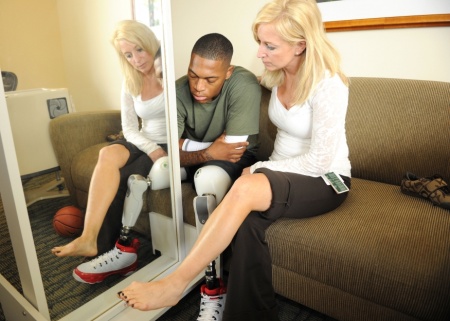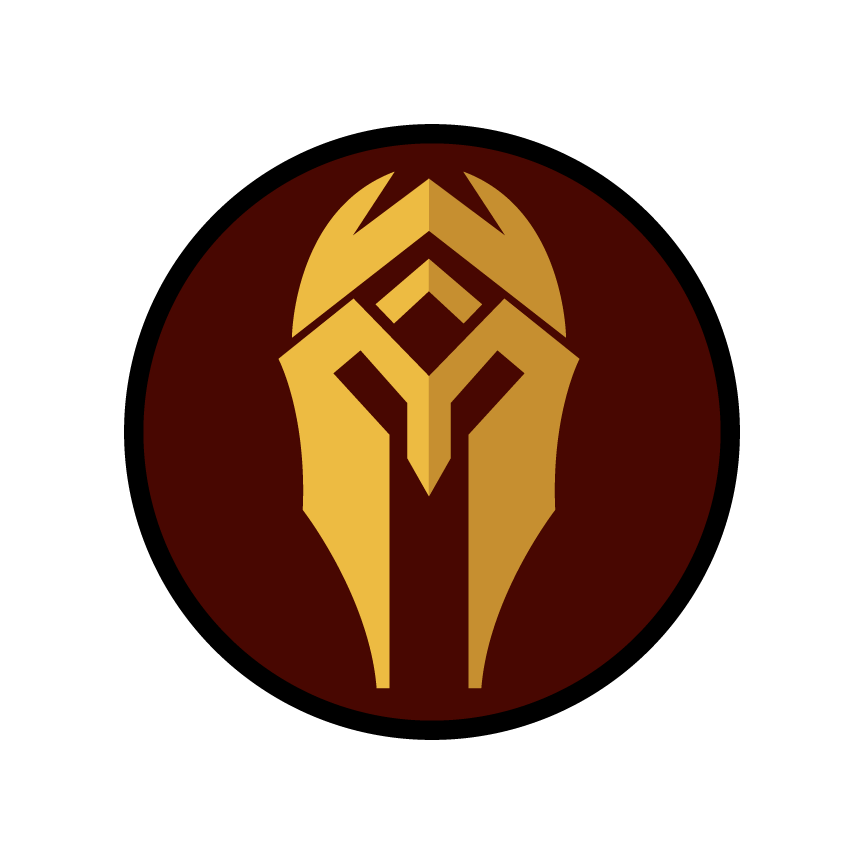Mirror Therapy
Caring for Patients with Amputations (Part two of a series)
In part one of this series we discussed the phenomenon known as phantom limb pain. That article laid the foundation for what follows. It essentially revealed that there is a strong connection between the brain’s awareness of the body and vision. The brain coordinates its perception of self through the combined senses of proprioception and sight. When there is conflict between what the brain expects to see, proprioception, and the reality of a missing limb, phantom limb pain can occur.1 Recognizing the distinct visual association between the brain and the neuromatrix and how strongly the interactive sense of self responds to visual cues, researchers have developed a simple non-pharmaceutical treatment for phantom limb pain. That treatment is Mirror Therapy.
Mirror Therapy
Mirror therapy utilizes a mirror placed in such a way that the patient can look in the mirror and see the mirror image of the non-amputated limb instead of the missing extremity. Somehow this treatment is successful in reducing or eliminating phantom limb pain. The mirror tricks the brain into thinking that the missing limb is still there, resulting in a significant therapeutic response. For many patients, the phantom limb pain resolves or the intensity of the pain decreases.
In one randomized controlled study, every one of the amputees in the mirror therapy group showed a reduction in phantom limb pain.2 The therapy consisted of 15 minutes of mirror therapy, five days per week for four weeks. While this study was done with the most basic of equipment, a mirror, the success of this study and others has led to the production of mirror systems specifically created to treat phantom limb pain. Mirror boxes and inflatable mirror boxes are now available commercially.
In cases of bilateral amputation, there is no limb to mirror. For this, the use of a surrogate has proven effective. Essentially the patient sees the limbs or mirror images of the limbs of another person, a surrogate.3
Research is continuing to uncover the mysteries of the neuromatrix, pain, and phantom limb pain. Studies currently underway are using advanced brain imagery to determine the effects of mirror therapy on the somatosensory cortex of the brain. In the future expect to see a refining of both the explanation of phantom limb pain, the utilization of mirror therapy, and in all likelihood, the use of visual goggles and virtual reality to treat patients with phantom limb pain and other conditions.
As research continues we can anticipate a refinement and expansion of non-invasive and non-pharmaceutical treatment of phantom limb pain. We can also expect to see the knowledge gained in treating phantom limb pain applied to other pain syndromes. It will certainly be exciting to see the trend of supporting and enhancing the brain’s own innate self-healing and the increased reliance on neural plasticity over the use of pharmaceuticals.
Looking Ahead
While research has shown success in treating phantom limb pain with mirror therapy, I expect that that other conditions such as strokes, denervation, mangled limbs, complex regional pain syndromes (CRPS),4 5 and cerebral palsy will also be treated with mirror therapy and eventually with virtual reality therapy using goggles. These types of therapy are in alignment with chiropractic’s historic philosophy of avoiding the unnecessary use of drugs and our desire to normalize neural tone and function. Certainly with hundreds of chiropractors now working in the VA and DOD healthcare systems and with an increasing number of veterans entering the civilian sector of healthcare, it is very likely that chiropractors will work with patients with [war wounded] amputations and phantom limb pain. We should be well-versed in the unique neurological and physiological nuances associated with amputations as well as with the mechanical changes which are manifested by these patients.
Disclaimer
The views expressed in this article are those of the author and do not necessarily reflect the official policy or position of the Department of the Navy, Department of the Army, Department of Defense, nor the U.S. Government.
Acknowledgement
I would like to acknowledge and thank the Defense Video and Imagery Distribution System for providing the photographs accompanying this article (figures 1 and 2). This work, Mirror Therapy Shows Promise in Amputee Treatment, by Donna Miles, identified by DVIDS, is free of known copyright restrictions under U.S. copyright law.
Additionally, I would like to thank Paul Pasquina, MD and Jack Tsau, MD for their work in advancing the state of the science in treating phantom limb pain and other pain syndromes. I thank them for freely engaging with me and sharing their knowledge as I try to understand their work.

 Figure 2. In cases where the patient has had bilateral amputation, the use of a surrogate(another person whose legs are used to provide the image of having legs) has been effective in treating phantom limb pain. Lynn Boulanger, an occupational therapy assistant and certified hand therapist, uses mirror therapy to help address phantom pain for Marine Cpl. Anthony McDaniel.
Figure 2. In cases where the patient has had bilateral amputation, the use of a surrogate(another person whose legs are used to provide the image of having legs) has been effective in treating phantom limb pain. Lynn Boulanger, an occupational therapy assistant and certified hand therapist, uses mirror therapy to help address phantom pain for Marine Cpl. Anthony McDaniel.2 Chan BL, Witt R, Charrow AP, Magee A, Howard R, Pasquina PF, Heilman KM, Tsao JW (2007) Mirror therapy for phantom limb pain. N Engl J Med 357:2206–2207.
3 Tung ML, et al. Observation of limb movements reduces phantom limb pain in bilateral amputees. Annals of Clinical and Translational Neurology .2014: 1: 9: 633–638.
4 McCabe CS, Haigh RC, Blake DR. A controlled pilot study of the utility of mirror visual feedback in the treatment of complex regional pain syndrome (type 1). Current Pain and Headache Reports. April 2008, Volume 12, Issue 2, pp 103-107.
5 Al Sayegh S, et al. Mirror therapy for Complex Regional Pain Syndrome (CRPS)—A literature review and an illustrative case report. Scandinavian Journal of Pain , Volume 4 , Issue 4 , 200 – 207.
